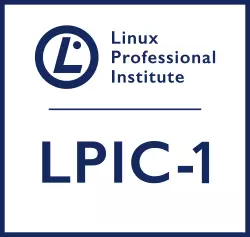Certificazione LPIC-1
 La Certificazione LPIC-1, prima certificazione di livello professionaltra quelle previste dal Linux Professional Institue (LPI), convalida specifiche competenze tecniche nell'installazione e nella configurazione del sistema operativo Linux, nell'esecuzione di attività di manutenzione sulla command line e nella configurazione di una rete. La certificazione LPIC-1 nasce dall'esigenza di facilitare le organizzazioni aziendali nella selezione e nell'individuaizone di profili IT in possesso di specifiche skill in riferimento al sistema operativo Linux.
La Certificazione LPIC-1, prima certificazione di livello professionaltra quelle previste dal Linux Professional Institue (LPI), convalida specifiche competenze tecniche nell'installazione e nella configurazione del sistema operativo Linux, nell'esecuzione di attività di manutenzione sulla command line e nella configurazione di una rete. La certificazione LPIC-1 nasce dall'esigenza di facilitare le organizzazioni aziendali nella selezione e nell'individuaizone di profili IT in possesso di specifiche skill in riferimento al sistema operativo Linux.
Come ottenere la certificazione LPIC-1
Per conseguire la certificazione LPIC-1 è necessario superarare gli esami 101-500 e 102-500.
corso LPIC-1
Caratteristiche esami 101 e 102
- Durata: 90 minuti
- Quesiti: 60
- Lingua: Inglese - Tedesco - Spagnolo - Portoghese
- Prerequisiti: Nessun prerequisito ma è consigliato il possesso della certificazione Linux Essentials
Validità e Rinnovo
Validità: 5 anni
Rinnovo: Non necessario
Argomenti d'esame 101-500
- Topic 101: System Architecture
- Determine and configure hardware settings
- Boot the system
- Change runlevels / boot targets and shutdown or reboot system
- Topic 102: Linux Installation and Package Management
- Design hard disk layout
- Install a boot manager
- Manage shared libraries
- Use Debian package management
- Use RPM and YUM package management
- Linux as a virtualization guest
- Topic 103: GNU and Unix Commands
- Work on the command line
- Process text streams using filters
- Perform basic file management
- Use streams, pipes and redirects
- Create, monitor and kill processes
- Modify process execution priorities
- Search text files using regular expressions
- Basic file editing
- Topic 104: Devices, Linux Filesystems, Filesystem Hierarchy Standard
- Create partitions and filesystems
- Maintain the integrity of filesystems
- Control mounting and unmounting of filesystems
- Removed
- Manage file permissions and ownership
- Create and change hard and symbolic links
- Find system files and place files in the correct location
Argomenti d'esame 102-500
- Topic 105: Shells and Shell Scripting
- Customize and use the shell environment
- Customize or write simple scripts
- Topic 106: User Interfaces and Desktops
- Install and configure X11
- Graphical Desktops
- Accessibility
- Topic 107: Administrative Tasks
- Manage user and group accounts and related system files
- Automate system administration tasks by scheduling jobs
- Localisation and internationalisation
- Topic 108: Essential System Services
- Maintain system time
- System logging
- Mail Transfer Agent (MTA) basics
- Manage printers and printing
- Topic 109: Networking Fundamentals
- Fundamentals of internet protocols
- Persistent network configuration
- Basic network troubleshooting
- Configure client side DNS
- Topic 110: Security
- Perform security administration tasks
- Setup host security
- Securing data with encryption
La lista qui riportata fornisce un'indicazione generale degli argomenti affrontati nell'esame. Si ricorda tuttavia per motivi di trasparenza che tale elenco potrebbe essere modificato da LPI in qualunque momento e senza preavviso alcuno.
Link risorsa ufficiale (LPIC-1 su lpi.org)
Panoramica generale Certificazioni Linux Professional Institute

